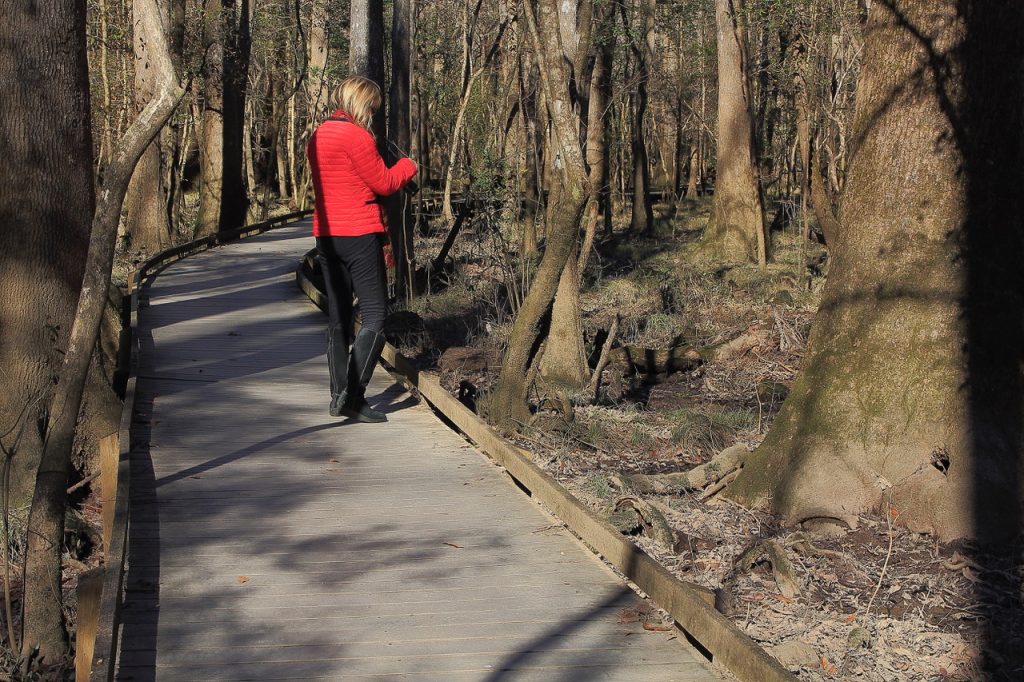A Walk In Winter Woods
March 29, 2023By Tom Poland
I like boardwalks. Those that take you through protected natural areas. Several come to mind. The lovely boardwalk at Woods Bay takes you 1,150 feet through a cypress-tupelo swamp. Edisto Gardens’ 2,600-foot boardwalk also takes you through a cypress-tupelo swamp while flirting with the Edisto River of redbreast fame. My favorite is the 2.6-mile boardwalk at Congaree National Park.
You can walk Congaree’s trail of sturdy posts and planks in 60 to 80 minutes. Why hurry? Take your time. You’ll walk something rare—North America’s largest remaining tract of old-growth bottomland hardwood forest. You’ll see American beech trees, bald cypress, and water tupelo. You’ll crane your neck. What a tall canopy. Don’t miss the ruins of an old moonshine still. See redhead woodpeckers, deer, and myriad bird species. See rich brown muck, switchcane, and cypress knees standing like meerkats on alert.
And fellow humans.
What struck me on this cold sunny day were the numerous visitors from across the United States. When you go to these woods note the license plates in the parking lot. I spent a few minutes talking with a young couple from California. They intend to move to South Carolina. Curious, I asked why. “We have five children aged 2 to 10. We don’t want them to grow up in California.” Make of it what you will, but it seems they’re escaping change. Had a ghost stood nearby, his hat askew, he could have told them how change threatened Congaree Swamp as it was known but trees can’t move. You move people to protect them. That is, help them feel and see the need to preserve our remaining unique nature areas.

Harry R.E. Hampton (July 8, 1897-1980) did just that. He set out to save what remained of a green cathedral. In the 1890s, loggers felled some bald cypress monarchs whose water-soaked logs sunk in revenge rather than float downriver to sawmills. The oft-flooded swamp, too spongy for road building caused frustrated loggers to abandon operations. Only nature has touched Congaree since.
Nature set what would be the country’s 57th national park and South Carolina’s first along the Congaree River’s north bank some 20 miles southeast of Columbia. There, the interplay of sunlight, minerals, and water sustains a 22,200-acre biome—the country’s largest contiguous tract of old-growth bottomland hardwood forest. It’s a must see, a bucket list item.
Jim Goller is the executive director of the Harry Hampton Wildlife Fund. When asked about the Fund and why it’s named for Harry, he tells people, “The HWF was formed in 1981, not long after Harry’s death in 1980. I consider Harry Hampton one of South Carolina’s first true conservationists.”
Indeed, he is. Hampton grew up in Columbia and Charleston when state governing of wildlife consisted only of rudimentary law enforcement. As a youth, Hampton explored, hunted, and fished a then-undeveloped South Carolina.
When he was a news reporter for The State newspaper, Hampton’s conservation interests culminated in 1931 with a massive publicity campaign to organize a game and fish association, instigate natural resources legislation, and form a state game commission. The resulting association later became the South Carolina Wildlife Federation.
While he was Federation president, Hampton’s constant hounding of the legislature influenced game and fish laws as well as the formation of the State Wildlife Department and Commission in 1952. Ultimately it evolved into the S.C. Department of Natural Resources. A visionary, Hampton’s 20-year battle to preserve the Congaree River bottom ended in success with the Congaree’s establishment as a National Natural Monument in October 18, 1976. Significant Designations kept coming: International Biosphere Reserve—June 30, 1983. Wilderness—October 24, 1988. Globally Important Bird Area—July 26, 2001, and the crown jewel, National Park—November 10, 2003.
In years to come, I hope the many visitors take a moment to learn about Harry Hampton and the HHWF. As Robert Frost wrote, “Whose woods these are I think I know.”
They’re Harry’s, yours and mine.
Learn more about Congaree National Park.
Learn more about the Harry Hampton Wildlife Fund.
Georgia native Tom Poland writes a weekly column about the South, its people, traditions, lifestyle, and culture and speaks frequently to groups in the South. Governor Henry McMaster conferred the Order of the Palmetto upon Tom, South Carolina’s highest civilian honor, stating, “His work is exceptional to the state.” Poland’s work appears in books, magazines, journals, and newspapers throughout the South.
Visit Tom’s website at www.tompoland.net
Email him at [email protected]


















